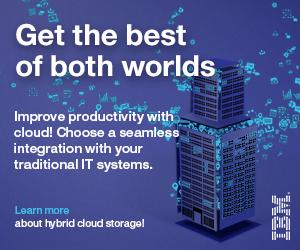Hybrid Cloud Storage Delivers Performance and Value
on March 29, 2017

Hybrid Cloud Storage Delivers Performance and Value
Just in the past two years, technology has created a veritable ocean of data. And like an ocean, that data, created by social technology, mobile technology and IoT, is vast, bountiful and dynamic. And also like an ocean, the climate, or temperature of data, constantly shifts and changes. Chances are that your enterprise has perhaps not an ocean, but certainly a sea or lake of data readily available. The challenge is how to measure the temperature, navigate the vastness of that data and reap its waiting bounty.


Just in the past two years, technology has created a veritable ocean of data. And like an ocean, that data, created by social technology, mobile technology and IoT, is vast, bountiful and dynamic. And also like an ocean, the climate, or temperature of data, constantly shifts and changes. Chances are that your enterprise has perhaps not an ocean, but certainly a sea or lake of data readily available. The challenge is how to measure the temperature, navigate the vastness of that data and reap its waiting bounty.
Data generally can be grouped into three classifications: hot, warm and cold. Hot data is data (such as customer behavior) that is accessed frequently and so needs to be available immediately. Cold data (for example, prior year financials), on the other hand, is used infrequently, and it does not need to be accessed as often. Warm data is somewhere in between, and as you can imagine, each class of data has different storage requirements. And, like the shifting nature of an ocean, your data may move between those classifications, making the challenge of storing and accessing your data in the most cost-effective way a huge challenge, and opportunity.
Most enterprises have relied on one of two general methods for storing data: on-site or cloud. Each of these approaches has its merits, but using one or the other also creates certain constraints for your enterprise. On-site storage provides all the benefits of localized control, but as your data grows or shifts between hot and cold, it can present cost issues. To respond to the cost and scalability issues, your enterprise can move its data to the cloud, but potentially at the risk of availability or regulatory compliance, like PII (personally identifiable information).
But if your enterprise could blend the two--on-site and cloud storage--in a way that helped manage down costs while providing for your enterprise availability, scalability, security and compliance needs, it would provide a viable solution. Hybrid Cloud Storage (HCS) creates a perfect method for your enterprise to place data exactly where it makes sense, depending on its class, and it helps manage costs effectively.

To derive the most benefit from HCS, look for a partner that provides deployment options based on your data workloads and that uses the same technology for on-site and cloud storage. This will make management of data and balancing much easier than trying to blend different technologies for cloud and on-site storage. Ask how your partner allows you to manage your storage needs. It is important to be able adjust and scale at as granular a level as possible with simplicity and ease. Keep in mind also the need to manage seasonal and unforeseen data storms in a way that doesn’t break your budget. A good partner will help you keep costs and performance on keel across your application and data portfolio in response to sudden data growth so that the right applications get the right data in the right timing to fuel your business.
A good HCS partner will provide a solution that allows your enterprise to move data to the most efficient storage location while simplifying the management of that data through automation of defined policies. Your enterprise should expect real-time access and availability, reliability, scalability and disaster recovery at lower costs than a strictly on-site solution.
There is a lot of data out there. If your job is figuring out the most accessible, secure and cost-effective way of storing and serving that data to your business, hybrid cloud storage is worth your strong assessment. Whether your enterprise is using on-site or cloud storage now, a move to HCS is a smart move.
Read more on how HCS can help your business now
Special thanks to IBM for sponsoring this blog, a series independently written by Linux Journal.










